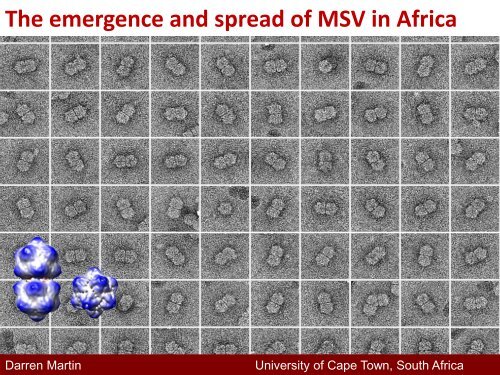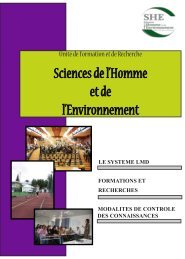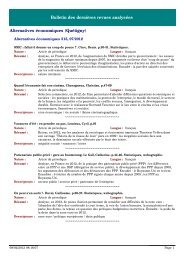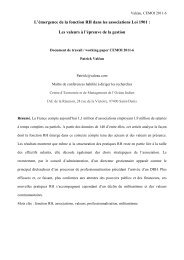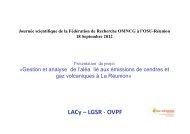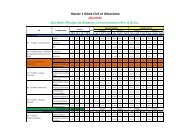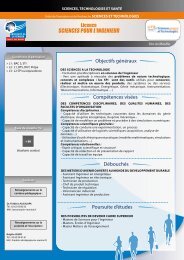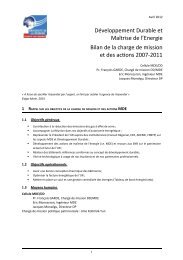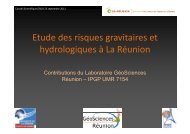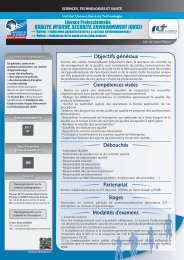Reconstructing the history of Maize streak virus ... - RUN-Emerge
Reconstructing the history of Maize streak virus ... - RUN-Emerge
Reconstructing the history of Maize streak virus ... - RUN-Emerge
Create successful ePaper yourself
Turn your PDF publications into a flip-book with our unique Google optimized e-Paper software.
The emergence and spread <strong>of</strong> MSV in Africa<br />
Darren Martin<br />
University <strong>of</strong> Cape Town, South Africa
The <strong>history</strong> <strong>of</strong> maize <strong>streak</strong> disease<br />
<strong>Maize</strong> introduced to West Africa by <strong>the</strong><br />
Portuguese in <strong>the</strong> early 1500s<br />
Leaf chlorosis<br />
Deformed cobs<br />
Stunting<br />
Yield losses <strong>of</strong> up to 100%<br />
It reached sou<strong>the</strong>rn Africa in <strong>the</strong> mid<br />
1600s with <strong>the</strong> Dutch East India<br />
Company<br />
<strong>Maize</strong> <strong>streak</strong> disease was first described<br />
in 1901 in sou<strong>the</strong>rn Africa<br />
It had affected maize <strong>the</strong>re since at least<br />
<strong>the</strong> 1870s suggesting that <strong>the</strong> maizeadapted<br />
MSVs had already evolved by<br />
<strong>the</strong> mid 1800s
MSV-A: The maize adapted MSV<br />
There are 11 known MSV strains - <strong>the</strong>y<br />
are named MSV-A through MSV-K<br />
MSV-K<br />
MSV-A 4<br />
MSV-C<br />
MSV-A 6<br />
MSV-D<br />
MSV-E<br />
MSV-A 3<br />
MSV-B MSV-A 2<br />
O<strong>the</strong>r MSV strains<br />
MSV-J<br />
0.025 substitutions<br />
MSV-I<br />
per site<br />
0.05 substitutions<br />
per site<br />
MSV-A<br />
MSV-F<br />
MSV-G<br />
MSV-H<br />
O<strong>the</strong>r African <strong>streak</strong> <strong>virus</strong>es<br />
MSV-A 1<br />
Only MSV-A is known to cause serious<br />
disease in maize<br />
MSV-B to -K, collectively referred to as<br />
“grass infecting” or non-maize adapted<br />
MSVs – produce very mild symptoms in<br />
even <strong>the</strong> most MSV-sensitive maize<br />
genotypes<br />
MSV-A classified into 5 subtypes/variants<br />
Species > 75% identity<br />
Strain > 89% identity<br />
Subtype > 98% identity Digitaria sp.<br />
<strong>Maize</strong>
Where did MSV-A come from?<br />
Large-scale cataloguing <strong>of</strong> inter-strain MSV<br />
recombination<br />
Revealed clear evidence <strong>of</strong> recombination<br />
hot-spots in non-coding regions<br />
MSV-A variants are all descendants <strong>of</strong> <strong>the</strong><br />
recombinant progeny <strong>of</strong> ancestral MSV-B<br />
and MSV-G/-F variants
Distributions <strong>of</strong> African <strong>streak</strong> <strong>virus</strong>es<br />
African <strong>streak</strong> <strong>virus</strong>es<br />
MSV<br />
MSV-A<br />
A 6<br />
MSV<br />
PanSV-G<br />
MSV-A<br />
A 3<br />
AfSVs like PanSV display<br />
strong geographical<br />
clustering<br />
PanSV-F<br />
PanSV-E<br />
A 1<br />
Are MSVs more mobile<br />
than PanSVs?<br />
MSV-B<br />
PanSV-B<br />
PanSV-C<br />
Is MSV-A more mobile<br />
than o<strong>the</strong>r MSVs?<br />
PanSV-A<br />
PanSV-D<br />
PanSV-H<br />
PanSV-I<br />
0.2 substitutions per site<br />
MSV-G<br />
MSV-F<br />
MSV-H<br />
MSV-E<br />
MSV-I<br />
MSV-J<br />
MSV-C<br />
MSV-K<br />
MSV-D<br />
A 4<br />
A 2<br />
If all <strong>the</strong>se <strong>virus</strong>es are<br />
evolving at <strong>the</strong> same<br />
rates <strong>the</strong>n Yes x 2<br />
Indian Ocean islands<br />
Sou<strong>the</strong>rn Africa<br />
West Africa<br />
East Africa
Evolution experiments<br />
How fast are AfSVs Mutating?<br />
Transmission from Coix back<br />
to sugarcane sometime<br />
between 1977 and 1986<br />
Natural <strong>virus</strong> populations<br />
SSRV - A (32 years)<br />
MSV - F (6 years)<br />
Transmission from<br />
sugarcane to Coix in 1976<br />
Sugarcane plants split into<br />
MSV - A – three <strong>Maize</strong> lineages adapted in strain 1984<br />
SSRV - A (32 years)<br />
2008 (Sugarcane)<br />
2008 ( Coix )<br />
1989 MSV (Sugarcane) - A 1<br />
(All across Africa)<br />
1991 MSV (Sugarcane)<br />
- A 2 (West Africa)<br />
1997 MSV (Sugarcane)<br />
- A 3 (East Africa)<br />
1987 MSV (Sugarcane)<br />
- A 4 (Sou<strong>the</strong>rn Africa)<br />
MSV - B (6 years)<br />
MSV - B (5 years)<br />
MSV - F (6 years)<br />
1991<br />
1997<br />
WDV –<br />
Wheat adapted strain<br />
MSV - B (6 years)<br />
European WDV<br />
Chinese WDV<br />
1991<br />
1997<br />
0.004 subs/site<br />
0.004 subs/site<br />
Diversity arising during evolution experiments is comparable to that seen Chinawide<br />
for Wheat dwarf <strong>virus</strong> or Sou<strong>the</strong>rn-Africa wide MSV-A 4 populations
How fast are AfSVs Mutating?<br />
SSRV and MSV in 5-32 year<br />
long evolution experiments<br />
evolve very fast<br />
Using substitution rate<br />
inference methods in<br />
programs such as BEAST we<br />
could accurately date events<br />
during <strong>the</strong> 32 year SSRV<br />
experiment<br />
This is an important<br />
validation <strong>of</strong> <strong>the</strong>se<br />
techniques
Is MSV evolving so fast in <strong>the</strong> field?<br />
~1924<br />
Found and sequenced some<br />
field isolates sampled between<br />
<strong>the</strong> late 1970s and <strong>the</strong> early<br />
1990s<br />
~1904<br />
~1967<br />
~1969<br />
A 4<br />
A 3<br />
A 2<br />
Taking recombination into<br />
account estimated substitution<br />
rates with BEAST<br />
1870-1904<br />
~1922<br />
A 1<br />
Most recent common ancestor <strong>of</strong><br />
all sampled MSVs existed in <strong>the</strong><br />
late 1800s at around <strong>the</strong> time<br />
MSD was first reported in<br />
sou<strong>the</strong>rn Africa<br />
Date<br />
Years ago<br />
Sou<strong>the</strong>rn Africa<br />
East Africa<br />
West Africa<br />
La Réunion island<br />
1860 1900 1910 1920<br />
150<br />
110<br />
1930<br />
1940<br />
1950<br />
1960<br />
1970<br />
1980<br />
1990<br />
2000<br />
100 90 80 70 60 50 40 30 20 10 0<br />
2010<br />
A 6
Is MSV really evolving so fast?<br />
Substitution rate estimates are very similar when using experimental<br />
populations and field isolates
What is <strong>the</strong> cause <strong>of</strong> high basal mutation rates?<br />
Substitution matrices are “imbalanced”<br />
indicating strand specific mutational<br />
processes<br />
Imbalance suggests mutational<br />
processes acting on ssDNA (e.g. in<br />
double stranded DNA <strong>the</strong> rates <strong>of</strong> G to T<br />
and C to A mutations should be <strong>the</strong><br />
same)<br />
High rates <strong>of</strong> G to T, G to A and C to T<br />
mutations suggest viral ssDNA is<br />
particularly sensitive to oxidative<br />
stresses
When did MSV-A emerge?<br />
* best supported<br />
model sets<br />
The recombination event that generated MSV-A probably occurred after<br />
maize was introduced by <strong>the</strong> Dutch to sou<strong>the</strong>rn Africa<br />
The MRCA <strong>of</strong> all MSV-As probably existed within 20 years <strong>of</strong> <strong>the</strong><br />
recombination event taking place
Where did MSV-A emerge?<br />
Haplotype Classification<br />
Legend<br />
MSV-A 1<br />
MSV-A 3<br />
MSV-A 2<br />
MSV-A 4<br />
MSV-A 2 , -A 3 , -A 4 like variant<br />
MSV-A 2 , -A 4 like variant<br />
MSV-A 2 , -A 7 like variant<br />
MSV-A 6<br />
year<br />
2000 – 2008<br />
Using >350 MSV full genomes with<br />
known sampling coordinates we<br />
looked at <strong>the</strong> contemporary (2000-<br />
2008) distributions <strong>of</strong> 10 MSV-A 1<br />
and 2 MSV-A 4 lineages (groups <strong>of</strong><br />
<strong>virus</strong>es all sharing <strong>the</strong> same<br />
recombination mosaics)<br />
MSV-A 1 s have a pan-African<br />
distribution MSV-A 4 is found only in<br />
sou<strong>the</strong>rn Africa
Where did MSV-A emerge?<br />
1863<br />
1933<br />
(1809-1935)<br />
(1867-1950)<br />
Root probability<br />
0.35<br />
0.30<br />
0.25<br />
0.20<br />
0.15<br />
0.10<br />
0.05<br />
0.00<br />
0.35<br />
0.30<br />
0.25<br />
0.20<br />
0.15<br />
0.10<br />
0.05<br />
0.00<br />
Root probability<br />
Full-genome dataset<br />
Recombination-free dataset<br />
Discrete phylogeography models (taking only countries <strong>of</strong> origin into account)
Where did MSV-A emerge?<br />
Continuous phylogeography models (taking actual GPS coordinates into account)<br />
Full genome dataset<br />
(80% HPD)<br />
1887(1842-1939)<br />
Recombination free<br />
dataset (80% HPD)<br />
1901 (1828-1941)
What are <strong>the</strong> most obvious movements?<br />
Age <strong>of</strong> migration (years before 2008)<br />
BF<br />
TD<br />
BE<br />
NG<br />
CAR<br />
CM<br />
UG<br />
KE<br />
Bayes Factor<br />
0<br />
10<br />
20<br />
30<br />
ZM<br />
ZW<br />
RE<br />
< 3.2<br />
> 3.2<br />
> 10<br />
> 100<br />
40<br />
50<br />
60<br />
70<br />
80<br />
90<br />
ZA<br />
LS<br />
MZ<br />
Dataset<br />
Both<br />
Recombination free<br />
Full genome
A<br />
Are <strong>the</strong>re hotspots <strong>of</strong> recombinant genesis?<br />
B C D<br />
1995<br />
1975<br />
1994<br />
E<br />
(1997 -<br />
2002)<br />
MSV-A 1 I<br />
F<br />
(1970 -<br />
1980)<br />
MSV-A 1 II<br />
G<br />
(1988 -<br />
1998)<br />
MSV-A 1 III<br />
Every one <strong>of</strong> <strong>the</strong> 12 main MSV-A 1<br />
and MSV-A 4 lineages are inferred to<br />
have arisen in ei<strong>the</strong>r sou<strong>the</strong>rn Africa<br />
or East Africa<br />
1993<br />
1977<br />
1960<br />
(1987 -<br />
1999)<br />
MSV-A 1 IV<br />
H<br />
(1967 -<br />
1985)<br />
MSV-A 1 V<br />
I<br />
(1949 -<br />
1971)<br />
MSV-A 1 VI<br />
J<br />
The geographical origins <strong>of</strong> <strong>the</strong>se<br />
lineages are supported by analyses<br />
<strong>of</strong> both full- genome and<br />
recombination-free datasets<br />
1975<br />
1998<br />
1996<br />
(1967 -<br />
1983)<br />
MSV-A 1 VII<br />
K<br />
(1996 -<br />
2000)<br />
MSV-A 1 VIII<br />
L<br />
(1992 -<br />
1999)<br />
MSV-A 1 XI<br />
M<br />
Remember that <strong>the</strong>se lineages are<br />
defined by <strong>the</strong> recombination<br />
patterns <strong>the</strong>y carried<br />
1960<br />
(1950 -<br />
1968)<br />
MSV-A 1 XV<br />
1993<br />
(1981 -<br />
2000)<br />
MSV-A 4 I<br />
1947<br />
(1934 -<br />
1958)<br />
MSV-A 4 V<br />
Full-genome<br />
Recombination-free<br />
Sample location
Do different subtypes display <strong>the</strong> same<br />
movement dynamics?<br />
There may be differences in <strong>the</strong><br />
mobility <strong>of</strong> MSV-A 1 and MSV-A 4<br />
MSV-A 1 lineages that emerge in<br />
sou<strong>the</strong>rn Africa frequently (in ¾<br />
cases) move to East and/or West<br />
Africa<br />
Both MSV-A 4 lineages that emerged<br />
in sou<strong>the</strong>rn Africa stayed in<br />
sou<strong>the</strong>rn Africa
Wave-like east to west movements<br />
3.2<br />
6.0<br />
3.2<br />
< 4.8<br />
2.6<br />
5.9<br />
91.0<br />
7.1<br />
30.0<br />
< 3.7<br />
1975<br />
(1967-1983)<br />
MSV-A 1 VII<br />
< 4.4<br />
< 3.2<br />
< 3.9<br />
< 3.5
Wave-like east to west movements <strong>of</strong> MSV-A 1<br />
D<br />
76.2<br />
64.0<br />
72.0<br />
76.2<br />
73.7<br />
74.1<br />
2.3<br />
71.4<br />
9.1<br />
< 3.7<br />
1994<br />
(1988-1998)<br />
MSV-A 1 III<br />
< 4.4<br />
< 3.2<br />
< 3.9<br />
< 3.5
Dispersal rate (km per yr)<br />
How fast does MSV move across Africa?<br />
Recombination- free<br />
Continuous model<br />
Dispersal rates may have varied<br />
slightly over he last 100 years<br />
BUT detected differences are<br />
not significant<br />
60<br />
Dispersal rates<br />
50<br />
40<br />
30<br />
20<br />
On average over <strong>the</strong> past ~100<br />
years MSV has been moving at<br />
an average rate <strong>of</strong> 33Km/year<br />
(HPD = 15.6-51.6)<br />
10<br />
0<br />
Recombination<br />
free<br />
Full genome
Edward Rybicki - University <strong>of</strong> Cape Town, South Africa<br />
Aderito Monjane - University <strong>of</strong> Cape Town, South Africa<br />
Eric van der Walt - University <strong>of</strong> Cape Town, South Africa<br />
Betty Owor - University <strong>of</strong> Cape Town, South AfrIca<br />
Gordon Harkins - SANBI, South Africa<br />
Tania van Antwerpen - SASRI, South Africa<br />
Bradley Flett - ARC. South Africa<br />
Moses Ramusi - ARC, South Africa<br />
Darren Martin<br />
Dionne Shepherd<br />
Arvind Varsani<br />
Sunday Oluwafemi - Bowen University, Nigeria<br />
Innocent Zinga - University <strong>of</strong> Bangui, Central African Republic<br />
Appolinaire Tange - IRAD Yaounde, Cameroon<br />
Fidèle Tiendrebeogo, - Université de Ouagadougou, Burkina Faso<br />
Salem Samtally - MSIRI, Mauritius<br />
Pierre Lefeuvre - CIRAD, La Reunion<br />
Jean-Michel Lett - CIRAD, La Reunion<br />
Michel Peterschmitt - CIRAD, France<br />
Oliver Windram - University <strong>of</strong> Warwick, England<br />
Peter Markham - ex John Innes Centre, England<br />
Phillipe Lemey - Katholieke Universiteit Leuven, Leuven, Belgium<br />
Rob Briddon - NIBGE, Pakistan<br />
Siobhan Duffy - Rutguers University, USA<br />
Jane Polston - University <strong>of</strong> Florida, USA
Acknowledgements<br />
Arvind Varsani<br />
Carnegie Corporation <strong>of</strong> New York, USA<br />
Darren Martin<br />
Sydney Brenner Foundation<br />
Harry Oppenheimer Foundation, South Africa<br />
Wellcome trust research foundation, UK<br />
Dionne Shepherd<br />
Claude Leon Foundation and PANNAR (Pty) Ltd<br />
National Research Foundation, South Africa<br />
Harry Oppenheimer Foundation, South Africa<br />
University <strong>of</strong> Cape Town block grant, South Africa<br />
Wellcome trust research foundation, UK<br />
Marsden Fund, New Zealand<br />
University <strong>of</strong> Canterbury Early career research grant, New Zealand<br />
Bimolecular interaction centre seed grant, New Zealand


